The King is dead. Long live the King! Until recently, the Continental Grand Prix 5000 S TR road bike tire was the leader in performance for road cycling. However, new tires from ENVE SES Raceday 29 and Pirelli P Zero Race TLR RS have surpassed the Continental Grand Prix 5000 S TR model. These latest tires offer lower rolling resistance, reduced weight, and improved puncture resistance. Additionally, the introduction of the Continental Aero 111 front tire has opened a new frontier in tire design. Advances in aerodynamics have led to impressive performance improvements in road bike tires.
What makes a Road Bike Tire fast?
For a tire to be considered fast, it must have minimal energy loss while moving forward, mainly determined by rolling resistance. Pneumatic (air-filled) tires are generally efficient, but the choice of material, construction, profile and air pressure can significantly affect efficiency from one tire model to another. Furthermore, the front tire is the first part that interacts with the wind and can, as such, significantly influence the aerodynamics of the entire system, as we explain in detail in our trilogy on aerodynamics.
Until recently, road bike tires were primarily concerned with rolling resistance, puncture resistance, grip, and weight. Now, aerodynamics is at the forefront. As demonstrated by the new Continental Aero 111, the aerodynamics of the front tire can have a significant impact on overall aerodynamic performance.
To understand rolling resistance, we must examine what happens to a tire when it rolls on a bicycle. GCN has prepared some nice graphics, as shown on the right side. The bike tire undergoes constant compression and decompression at the bottom part, squeezed between the weight of the bike and the rider from above and the ground from below. Energy is lost when compressing the tire and regained as the tire releases energy while decompressing. However, the regain is always a little less than the loss. This difference between the two is commonly referred to as rolling resistance.
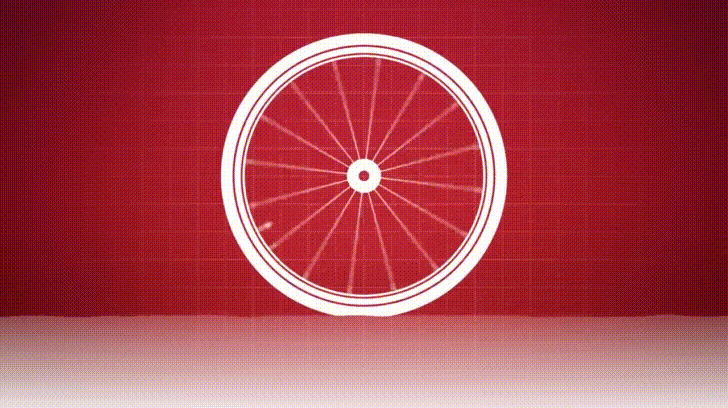
When a bike tire gets squished between the bike and the ground, it compresses and decompresses, causing energy loss as heat. This phenomenon is known as rolling resistance, and the top tires utilize special materials to minimize this loss.
The key to the fastest road bike tire is minimizing hysteresis
Inflating the tire with high pressure, which reduces compression, is the simplest and most obvious method of reducing rolling resistance loss. However, this method is only effective on very smooth surfaces. In the real world, various other factors come into play, which are covered in more detail in the article on rolling resistance. In short, you want to ensure that you have inflated your tire to the optimum pressure, based on your weight, tire properties, and intended use.
The goal of performance road bike tire construction is to minimize loss through the use of high-quality materials and efficient construction methods. The ultimate goal is to maximize the energy the tire returns after being compressed, similar to how the fastest running shoes perform. The physical concept behind this is known as “hysteresis.” If you’re interested in learning more, check out this video by Josh Poertner from Silca.
As such, manufacturers are challenged to strike a balance that makes the tire still stable and robust enough against punctures (we wouldn’t want to just roll on a latex tube) and likely have some limitations concerning costs. As consumers, we share the same objectives regarding tires – we want something that is both fast and puncture-resistant. Therefore, the perfect tire would find a balance between these two factors. An additional, very relevant factor for the front tire now comes into play: aerodynamics. Its importance can not be overstated, and the latest frontier in road bike tire design seems to be focused on it.
Road bike tire tread patterns influence aerodynamic performance
The front tire is the first part that hits the clean air right at the front of the bike’s performance zone. Together with the wheel, it can significantly influence the aero performance of the system. In fact, the little grooves on the side of the tire can make it more or less aerodynamic because these patterns can help optimize the airflow over the tire around the rim. If you had a chance to read our trilogy on aerodynamics, you would be able to connect the dots quickly.
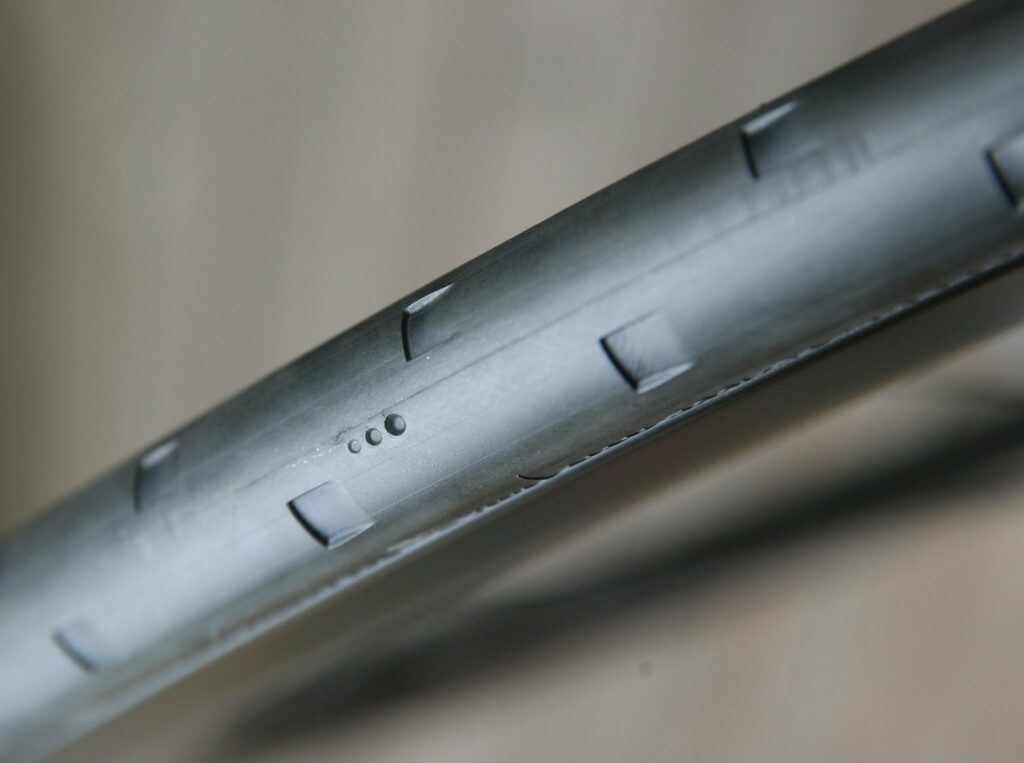
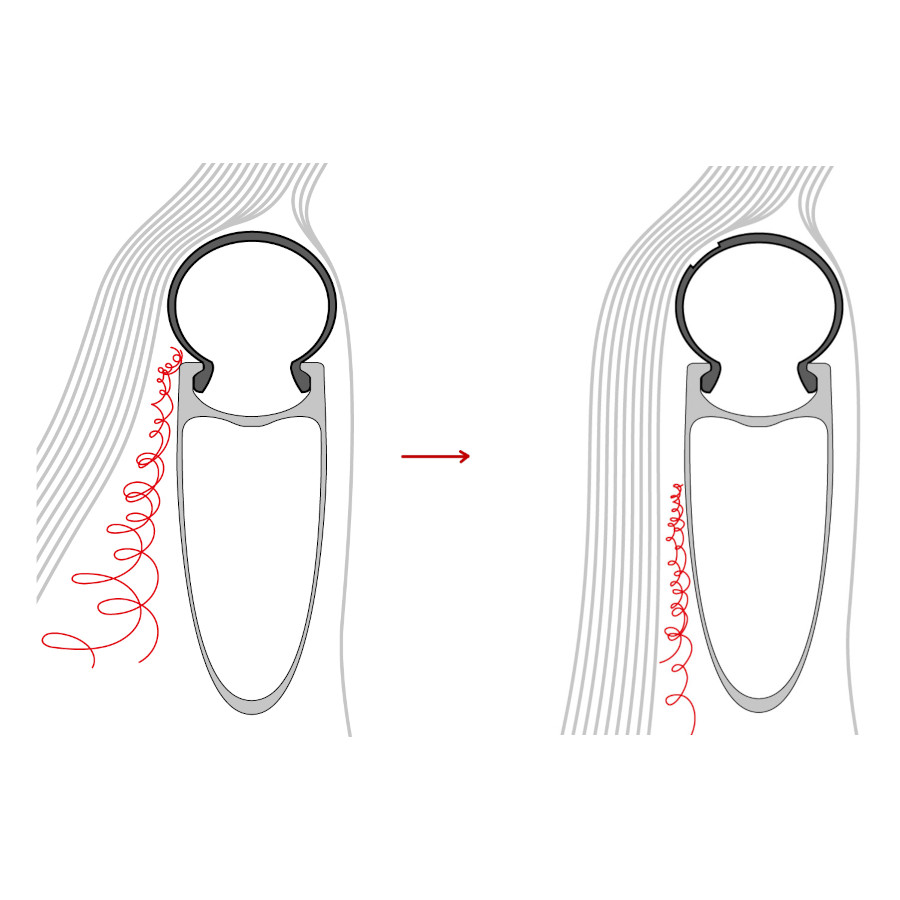
Little-known fact: The tread pattern on modern road bike tires is there to improve aerodynamics, not grip. The latest Continental Aero 111 tire was designed to take full advantage of this effect, whereas former models, such as the GP 4000 SII, were an accidental find.
For the longest time, the Continental GP 4000 was considered the most aerodynamic tire and everyone in the industry was trying to create something similar. However, it turns out that Continental initially added the pattern solely for design purposes, as customers believed it would improve grip. Contrary to popular belief, these patterns do not matter for grip. The grip is primarily determined by the tire material, rather than the tread pattern, since aquaplaning is not a significant concern in cycling. The leading brands have all developed materials with a formidable grip on the road, so it is less of a differentiator these days.
Choose brand-new tires fresh off the box for the best performance
Many tires now have markings to show when the tread has worn off and should be replaced. This is relevant not only to prevent punctures by wearing down a tire but also to avoid negatively affecting rolling resistance. The testing data on the Continental GP 5000 S TR by Bicycle Rolling Resistance can be considered a reference for all road bike tires.
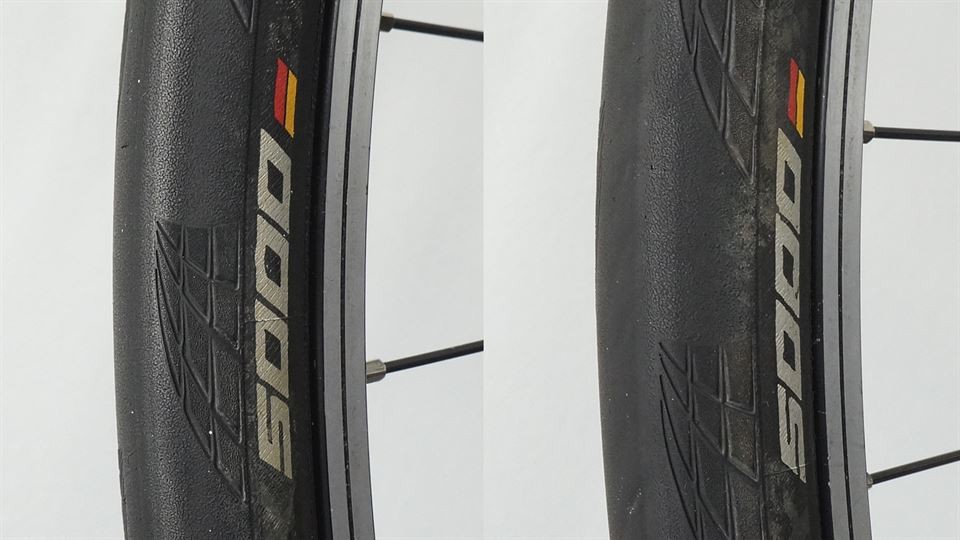
Based on the data, the tire has already lost its ultra-fast rolling properties after traveling 1000 km, showing an increase of 4-9% in rolling resistance. After that, however, the rolling resistance appears to be constant. The explanation is likely the loss of material and the resulting rebound loss by the casing or thread on brand-new tires. Once the initial material wears off, some advantageous rebound effect is lost, and rolling resistance increases.
The rolling resistance of road tires increases by 4-9% after the first couple of thousand kilometers. For optimal performance, it is recommended to use a new pair of tires right out of the box. This can be a significant upgrade when you prep your bike before race day. You can always put the older tires back on later for training.
In conclusion, installing a new pair of tires before a race can be beneficial for achieving optimal performance. This can also increase puncture resistance by providing a fresh sealant and full tread. If you are using tubeless tires, it is still advisable to ride a few times to ensure that the tire is seated properly.
The 3 fastest all-around Road Bike Tires
Based on the publicly available data, the following tires from Continental, Enve, and Pirelli appear to be the fastest all-around road tires:
- Fastest Combo: Continental Aero 111 with GP5000 S TR in the back (black sidewall!)
- Better puncture resistance, some aero optimization: Pirelli P Zero Race TLR RS
- Fastest Rolling, not aero optimized: ENVE SES Raceday
How was the fastest road bike tire chosen?
The most known resource is Bicycle Rolling Resistance, which has been run by Jarno Biermann since 2014. There, you can find many bike tires tested for rolling resistance, puncture resistance, weight, and various other parameters. The watt numbers provided there do not translate precisely into the real world because they are tested on a rolling drum. However, relative comparisons are still valid. If tire A has less rolling resistance than tire B, the same will be true out on the road. Moreover, as we have seen in our 2023 analysis, data from other sources confirms the results.
For this article, the database was filtered for the most common scenario of a fast, all-around race bike tire: around 28 mm width, tubeless (yes, of course!) and sorted by the rolling resistance at an air pressure of 5.0 bar (54 PSI), which is likely the most appropriate for most riders.
A 28 mm all-around tire with decent puncture protection and the lowest rolling resistance, at about 5 bars, is likely the ideal choice for most amateur riders. If feasible, use it on a tubeless setup with regularly maintained sealant.
A more difficult consideration is how much puncture resistance we deemed suitable for general road cycling. We did not consider specific time trial tires for this comparison, such as the Vittoria Corsa Speed or Veloflex Record. These are the absolute fastest tires around, but for most of us, we likely lose more with a puncture than we can save in watts and rolling resistance, as we do not have the logistics in place to swap wheels and bikes very quickly in case of a puncture.
The latest road race tires from Continental, ENVE and Pirelli are comparable in rolling resistance, weight, puncture resistance and wet grip
All three tires are the fastest in their categories, and their differences are likely minimal out on the road. Still, from a purely data-driven perspective, the ENVE SES Raceday is the fastest at 5.0 bar (74 PSI) with 9.3 watts, compared to 10.5 watts for both the Continental Aero 111 and the Pirelli P Zero Race.
For reference, the now classic Continental GP5000 S TR is a little faster at 9.7 watts than the Aero 111. According to the Bicycle Rolling Resistance test data, the Aero 111 features a casing design similar to the Grand Prix 5000 S TR, with a tougher two-layer + Vectran breaker under the tread and additional three-layer sidewalls, prioritizing durability over minimal rolling resistance. It uses Continental’s latest Black Chili compound, which seems to be different from the compounds used in the GP 5000 S TR and GP 5000 TT TR, incorporating the latest advancements to enhance performance.
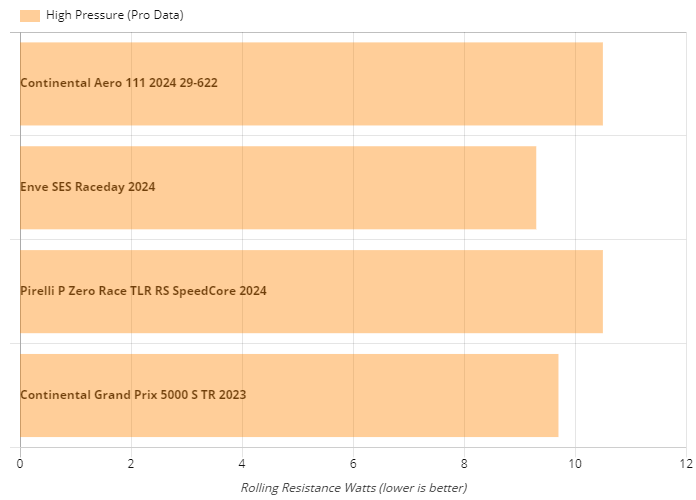
The measured weight and tire thickness correspond as expected. The less material there is, the faster the tire will be due to minimal hysteresis. The following graphs illustrate the same rank order. It is worth noting that the ENVE is significantly lighter than the others, particularly in the sidewall. Still, the 2 x 50 grams won’t significantly affect the entire rider and bike system.
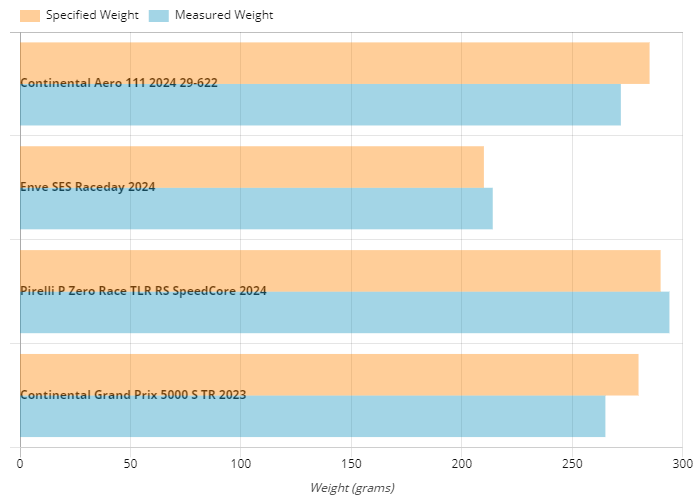

In terms of puncture resistance, the new Aero 111 outperforms the Grand Prix 5000 S TR by a significant margin, suggesting that a new and improved Black Chilly compound is being used. In the same way, the new Aero 111 outperforms all others when it comes to wet grip. Surprisingly, the ENVE performs very well despite using less material for puncture resistance. As seen before, the Pirelli appears to be marginally more robust.

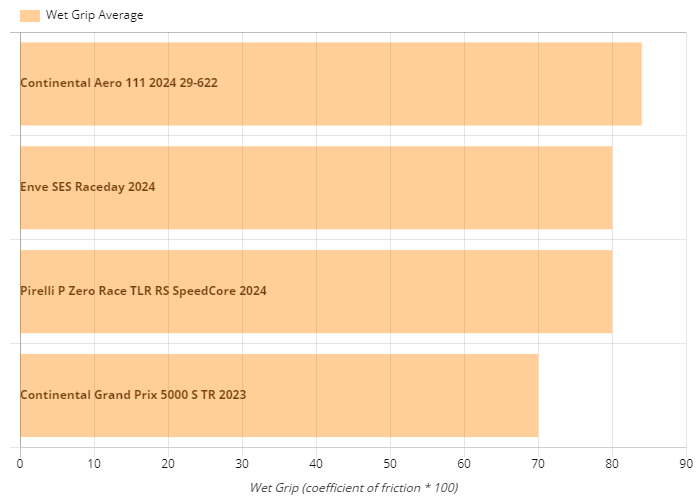
In summary, the Continental GP5000 S TR has lost the top spot based on the latest data. However, Continental has not been resting on its laurels and has released the new Aero 111 front tire. It lost a little in pure rolling resistance but gained in puncture resistance and wet grip, which seems to be a prudent design choice for a front tire. Overall, the differences between the latest top road race tires are very marginal from a pure tire performance perspective, yet as we see in the next chapter, aerodynamics is the new frontier.
Based on the latest rolling resistance and grip data, the Continental GP 5000 S TR has lost the top spot to ENVE SES Raceday and Pirelli P Zero Race TLR RS. Nevertheless, with the advent of the new Aero 111 front tire, the Continental combo is still the fastest choice.
A new frontier: influencing aerodynamics with the Continental Aero 111
As mentioned above, it has long been recognized that the front tire has a significant impact on the bike’s aerodynamics. This comes as no surprise, since the front tire and front wheels are the first components to encounter clean air in front of the rider. As we learned in our review of cycling aerodynamics, it’s the front where it matters. Therefore, an optimal tire and wheel combination will also provide an aerodynamic advantage. In July 2024, Continental launched the new Aero 111 tire in collaboration with Swiss Side aero engineers and wheel manufacturer DT Swiss. This is the first tire entirely developed to achieve superior aerodynamics on the front wheel, with technology based on the current Continental GP 5000 S TR.
The new Continental Aero 111 tire has been designed for the Swiss Side Hadron or DT Swiss ARC / ERC series of wheels. Independent testing from Aerocoach confirms the aerodynamic advantages of their Zephyr set of wheels. Likely, this innovation will also benefit other wheelsets.
What makes the Continental Aero 111 tire stand out from the competition?
The Aero 111 tire is intended for use as a front-wheel tire because its aerodynamic benefits are lost at the rear of the bike, also known as the “comfort zone.” Generally, its construction is similar to the current GP 5000 S TR tire, but it features side cutouts known as “vortex generators.” These cutouts help maintain airflow along the wheel’s rim, reducing aerodynamic drag. All claims about its performance have been supported by wind tunnel data from Swiss Side, which they provided at both the standard 45 km/h and 30 km/h speeds. Remember, what counts is the wind speed that hits and not the ground speed your bike computer shows, as discussed in a previous post. Therefore, the 45 km/h data is also relevant to “slower” riders.
The first dataset is the classic wind tunnel diagrams, which many of you may be accustomed to from wheel testing. Shown below for 30 km/h (left) and 45 km/h (right) are the changes of wind resistance in watts in comparison to the angle of the wind, also known as yaw. We talked previously about Yaw in our introduction to cycling aerodynamics. The graphs are fairly symmetrical because the wind can be angled from either direction.
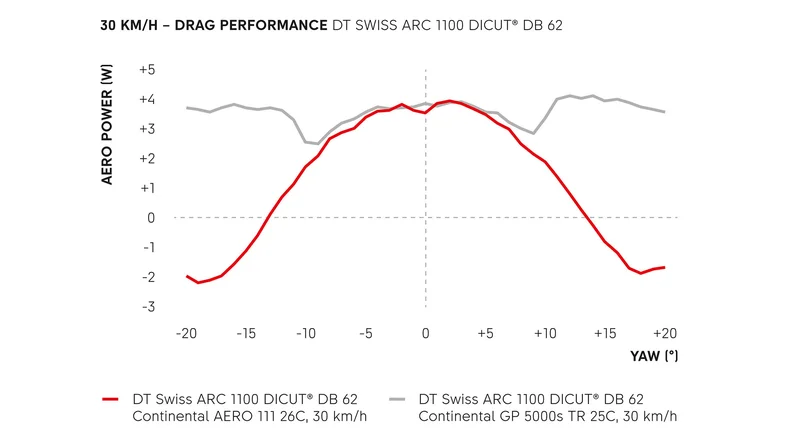
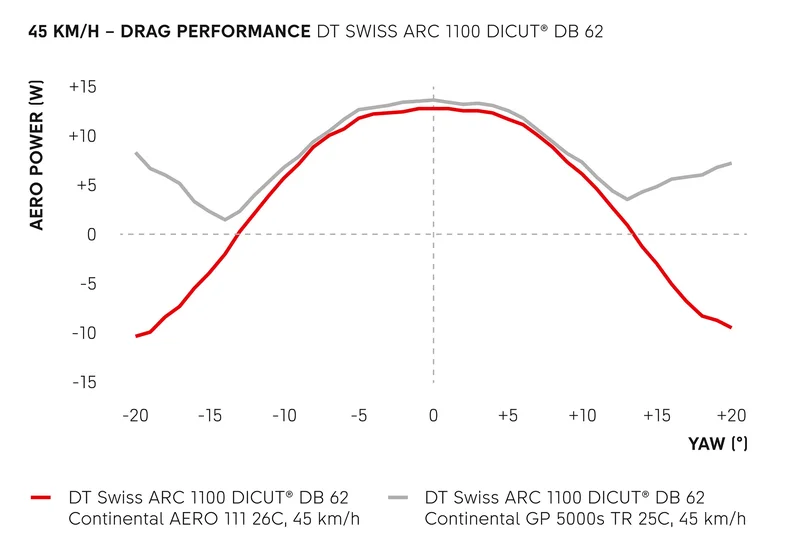
The Continental Aero 111 improves aerodynamics at high yaw angles and more so at slower speeds
In grey is the traditional setup with a 25 mm Continental GP5000 S TR tire, and in red is the corresponding new Aero 111. The Aero 111 has a significantly more pronounced influence on the aerodynamic profile compared to the standard setup. Looking at the data, it seems impressive what a relatively inexpensive upgrade can provide, as the advantages are similar to those of highly costly aero wheelsets.
The Aero 111 provides impressive aerodynamic advantages for such a relatively cheap upgrade. The benefits at higher yaw angles and lower speeds appear to be similar to what relatively costly aero wheelsets can achieve. At the extremes, there is a 20-watt difference at 45 km/h from a “sailing effect” compared to the Continental GP 5000 S TR.
The first observation is that the advantage of the new Aero 111 becomes apparent at wider yaw angles, where it significantly alters the performance. The wider the yaw angle, the greater the sailing effect it provides. At the extremes, there is a 20-watt difference at 45 km/h from a negative “sailing effect” with the Aero 111 compared to a positive, increased drag with the GP 5000 S TR. Unsurprisingly, it has little effect when the wind hits directly from the front. However, there may be some minor improvement at higher speeds.
The Continental Aero 111 maintains the sailing effect and aerodynamic advantage even at a slower speed of 30 km/h, making it ideal for slow riders or uphill sections. If you ride at just 20 km/h with a slight 10 km/h sidewind, you will already feel significant benefits.
Additionally, the effect is more substantial at slower speeds, which is to be expected. When riding at slower speeds, the airflow typically detaches sooner. Therefore, the effect may be even more noticeable for slower riders or on uphill sections. It’s important to consider that you might be riding at only 20 km/h, but with a 10 km/h headwind or sidewind, you can quickly reach speeds of 30 km/h. This is also in contrast to the Continental GP 5000, where the profiles at 30 km/h and 45 km/h differ significantly, with greater attachment at the faster speed. On the other hand, the new design of the Aero 111 appears to work equally well at 30 km/h, one of its main selling points.
Better control of the front wheel is a feature of the Continental Aero 111
Anyone who has ridden aero wheels has surely already experienced the effect of sudden pressure changes on the handlebar from side winds, which can make for a scary moment. Sometimes, it is more predictable when there is a gap between houses or trees on the side of the road. Still, especially in the high mountains, I have experienced terrifying moments when the wind direction changed while going through a tight corner.
The Continental Aero 111 appears to eliminate the scary wobbles of aero front wheels at sidewinds. The data shows a predictable profile on the 6 cm deep DT Swiss ARC wheels. Will this mean that deeper front wheels will find their return to the pro peloton?
As you have been pushing lightly against the pressure from the wind, suddenly, the pressure changes, and consequently, your steering wheel gives in, and you feel that slight wobble we are all scared of. This is also the reason why the typical recommendation is not to ride wheels with a depth of more than 40 to 50 mm in the front. The relationship between the pressure of the wind at different angles and the force on the handlebars can be measured in the lab as the “steering moment.” The early incarnations of aero wheels were especially susceptible to this, and the more modern profiles of the DT Swiss ARC wheelset have already improved upon that.
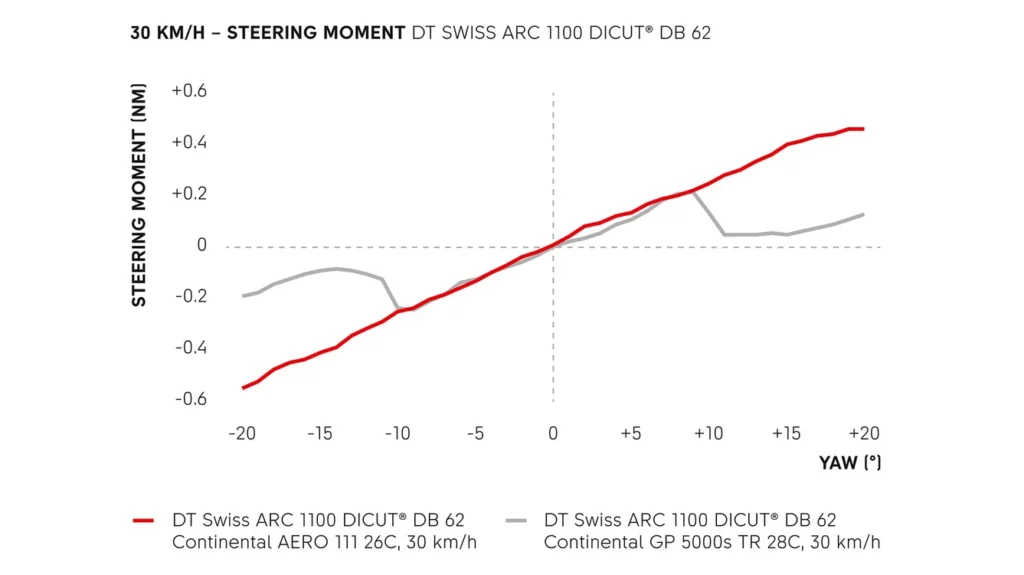

Based on the provided data, the Continental Aero 111 tire appears to be further enhancing its characteristics, exhibiting a linear and highly predictable steering moment at all yaw angles.
From my personal experience, the best thing the new Continental Aero 111 tire offers is excellent front wheel control, particularly on windy alpine descents. The pressure on the wheel is always predictable, with no sudden changes.
Compare it to the light grey line of the GP 5000 S TR tire on the same wheelset, at yaw angles of about 10° degrees (30 km/h) or 15° degrees (45 km/h), there is a sudden decrease in force on the handlebars, which creates these moments of a sudden loss of control.
The Continental Aero 111 outperforms all its competitors in the wind tunnel
The same wind tunnel data was also provided to compare the Aero 111 tire to the six other top-performing premium road bike tires: Schwalbe Pro Aero 28mm, Enve SES Road 25mm, Vittoria Corsa Speed TLR G+ 2.0 25mm, Cadex Aero Tubeless 25mm, Pirelli P Zero Race TLR 25 mm and finally Schwalbe Pro One. Unfortunately, the Continental GP5000 S TR was omitted from this graph, and the greyish color coding makes it a little tricky to discern the data. Anyway, let’s dig into the results.
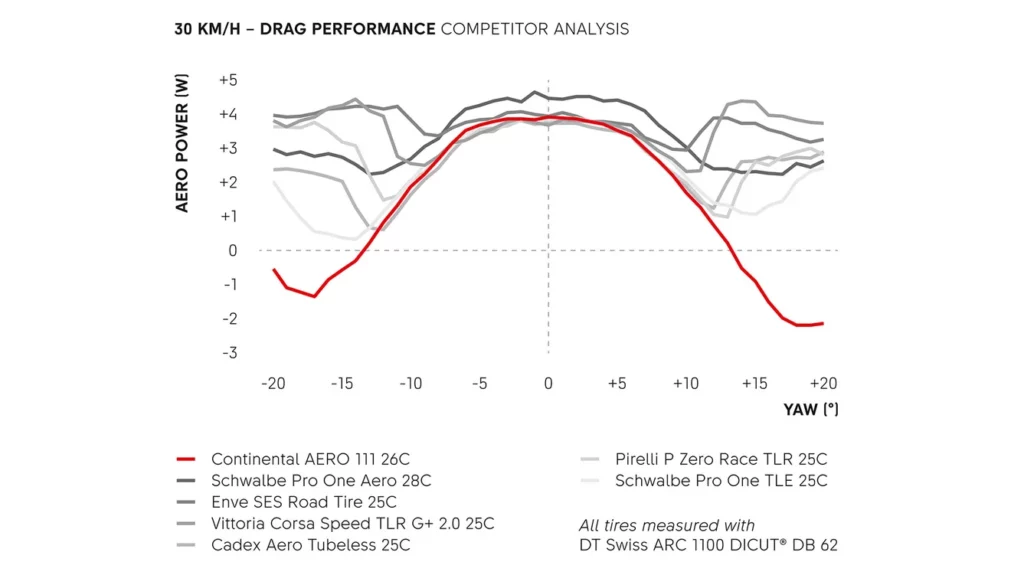
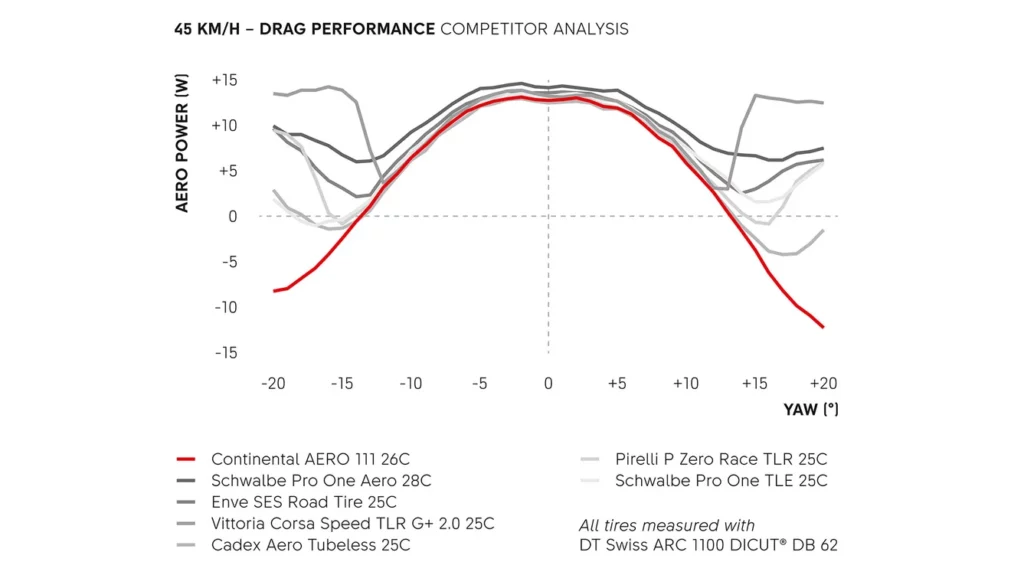
First, at 0° degrees and all narrow angles, all tires perform similarly, except for the Schwalbe Aero. This is not surprising, as the tire is 28 mm wide, and the DT Swiss ARC wheelset is optimized for 25 mm tires in the front.
There are significant differences in how tires perform at wider yaw angles, and the Aero 111 shows the most prominent advantages by far. What is interesting is that the Schwalbe Pro One, Cadex, and Pirelli also exhibit a significant sailing effect at wider angles, which can be assumed to result from consideration of aerodynamics. The model tested by Pirelli is the previous model (without the “RS”), but both share the same profile, so it can be assumed that the aerodynamics are the same or very similar.
The Pirelli P Zero Race tire exhibits some aerodynamic optimizations, whereas the ENVE SES RaceDay performance is relatively similar to that of a slick tire. Still, neither can match the new Continental Aero 111.
Finally, the Vittoria and ENVE, as well as the Continental GP 5000 S TR, all exhibit noticeable detachment and no improvements in aerodynamics. This is also no surprise, as both tires are relatively slick, which is known to be a disadvantage. Both manufacturers will likely improve their design in future models, as aerodynamics is now the new frontier in high-performance road bike tires.
Independent Testing from Aerocoach further confirms the aerodynamic advantage of the Aero 111
Aerocoach, a UK-based company specializing in aerodynamics testing and manufacturing, conducted a test to evaluate the rolling resistance and aerodynamic drag of the Continental Aero 111. They compared its performance to that of the Continental GP5000 TT and the Vittoria Corsa Pro Speed, a leading competitor in terms of rolling resistance. This is the first set of independent data from a renowned source for this novel tire.


The Aerocoach data further supports the official results provided by the manufacturer, based on a different wheel, their own Zephyr model. Specifically, the Aero 111 demonstrates reduced drag at higher yaw angles above 10 degrees. However, it’s important to note that the difference compared to the “classic” Continental GP5000 TT isn’t significant. A more notable distinction lies in rolling resistance: the Aero 111 ranks at 30.9 watts, which is considerably higher than the GP 5000 TT’s 23.1 watts. It’s worth mentioning that the GP 5000 TT is a time trial tire, which may not be suitable for general road riding. In contrast, the classic road tire Continental GP5000 S TR has shown a rolling resistance of 28.5 watts in a similar Aerocoach test.
The Continental Aero 111 is best used as a front wheel tire only. Aerocoach data indicate it offers aerodynamic benefits at yaw angles exceeding 10 degrees, but it exhibits higher rolling resistance.
Final Recommendations for Road Bike Tire Setup
From the data discussed in this post, the Continental Aero 111 appears to open up a new frontier in high-performance tire design. The importance of aerodynamics can not be underestimated, and this is especially true for slower riders, who stay longer on the course and are more susceptible to sidewinds, where it shows its most significant gains. The Aerocoach data further confirms its advantages, particularly the predictability of steering moment, which can greatly improve riders’ confidence and speed.
In all other cases, the new Pirelli P Zero Race TLR RS is an impressive combination of puncture resistance, wet grip and low rolling resistance. Given that it takes at least some considerations of aerodynamics into account, it can be highly recommended in almost any case. Theoretically, one could also combine it with the Aero 111 on the front. It may simply be an unusual aesthetic look.
Finally, ENVE created the fastest tire in terms of pure rolling resistance, especially considering its weight; however, it still lacks aerodynamic efficiency. If, for some reason, you still believe more in weight advantages (which certainly means you have not read this post!) or compete in windless places and only uphill, you surely can’t go wrong with this one.
Once you have the best rubber on your machine, don’t forget to set the correct pressure, as this is arguably even more relevant. Next, you may be interested in learning that choosing a fast tire is equivalent to saving kilograms of weight.
 Made me Slower
Made me Slower
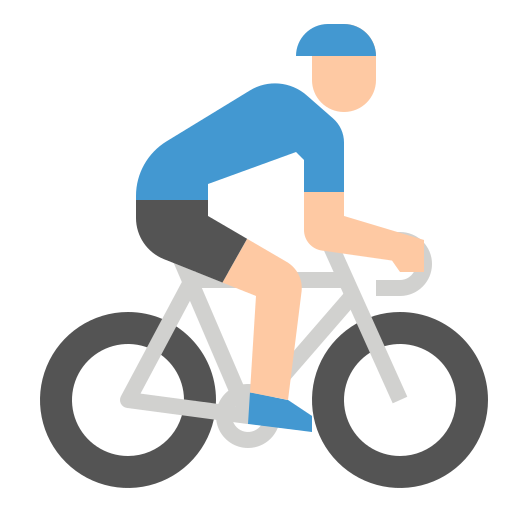 Same, Same
Same, Same
 Made me Faster
Made me Faster






